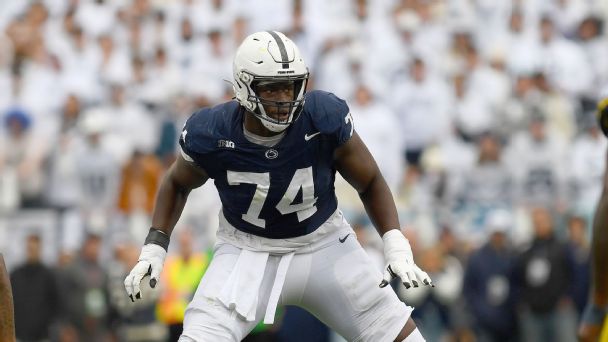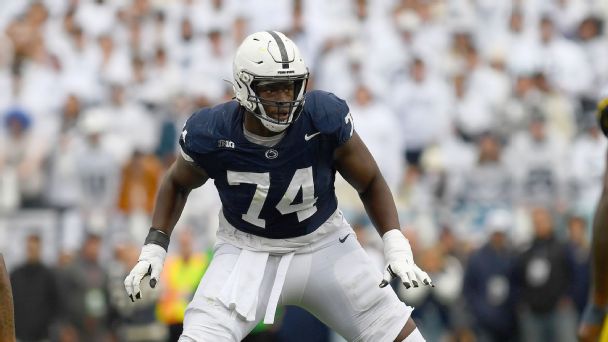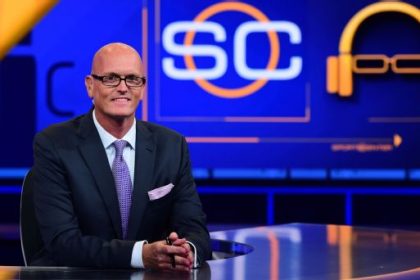
FLORHAM PARK, N.J. — A look at what’s happening around the New York Jets:
Looking for Mr. Right
From 2006 to 2015, the Jets never had to worry about left tackle. D’Brickashaw Ferguson was there every season, every game, every snap. Remarkably, he never missed a snap in his career due to injury; the only time he left the field was on a gadget play at the end of the 2008 season.
Since Ferguson’s retirement, the Jets have used 10 different starters at left tackle — a revolving door of players ranging in age from 21 (Mekhi Becton, 2020) to 37 (Duane Brown, 2023). The Jets long for stability at the critical position, and their hope is that first-round pick Olu Fashanu can match Ferguson’s longevity once he succeeds Tyron Smith.
It’s unusual for a high draft pick to start his career on the bench, but the Jets chose Fashanu after signing Smith, an eight-time Pro Bowl selection with the Dallas Cowboys. Ferguson, for one, believes there’s upside to easing the rookie into the lineup.
“The NFL has gotten to the place where they want immediate impact, but I think for people to learn what that transition is like to the league, it just benefits you,” Ferguson told ESPN.
“I’m excited for a player like him,” he added. “This is a ripe opportunity to grow in. Had the Jets not made so many moves, I think the expectation would’ve been even harder because now if he doesn’t perform, they’re going to look for other ways to make fixes. But I think they put him in a position to have success. I’m happy and excited to see where this goes.”
Ferguson, 40, a member of the Jets’ Ring of Honor, said he was rooting for New York to draft a tackle. When the team took Fashanu with the No. 11 pick, it brought back memories of the day he was selected fourth overall in 2006. He was a Day 1 starter and learned on the fly.
When he came out of Virginia, Ferguson was 6-foot-6, 310 pounds. Fashanu, from Penn State, is 6-foot-6, 312 pounds. Speaking from experience, Ferguson said Fashanu can rely on skill and technique early in his career, building strength and savvy over time.
Ferguson likes the new-look offensive line, noting the blend of youth and experience and calling Smith “an amazing player. I’ve always respected his game.” Ferguson hopes Fashanu will have the same opportunity that was afforded him — a chance to develop long-term chemistry with his linemates. Ferguson credited longtime teammates Nick Mangold and Brandon Moore with helping him succeed.
It’s unfair to expect Fashanu to duplicate Ferguson’s Iron Man streak. The league may never see something like that again. Asked about the team’s long struggle to replace him, Ferguson said humbly, “I thought Kelvin Beachum did an amazing job (from 2017 to 2019). I think there have been a lot of guys when they played, they did what they could.
“I think the game continues to evolve and it puts a lot of pressure on these players to perform at a high level. We don’t always know why things turn out the way they do. It wasn’t until the end of my career where I realized, ‘Hey, I’ve been playing this long and this consistently.’ To me, that’s what we were supposed to do.”
Taxing start
The Jets can’t be thrilled with the early part of their schedule. They open with three games in 10 days: road dates against the San Francisco 49ers (Sept. 9) and Tennessee Titans (Sept. 15), followed by the New England Patriots (Sept. 19) in a Thursday night home opener.
It’s a legitimate concern, especially with a 40-year-old quarterback coming off a major injury. Aaron Rodgers hasn’t played a full game since Jan. 8, 2023. By opening day, it’ll be a 20-month layoff.
Mike North, the NFL’s vice president for broadcast planning, said the Jets are among six teams with a three-game/10-day stretch during the season. He said the league tinkered with other scenarios, ultimately justifying the Jets’ start because the level of competition isn’t outrageous.
“Obviously, the three games in 10 days is a challenge,” he said, “but it didn’t feel like a gauntlet of three teams that made deep playoff runs last year.” He was including their Week 4 opponent, the Denver Broncos, in that sentiment.
Quirks in the schedule
The Jets have the ninth-best rest differential at +5 days, meaning they have five more rest days than their opponents. They also have no games against teams coming off a bye week. On the downside, they have four short weeks, tied for the second-most.
Familiar faces
Though not likely, it’s conceivable that the Jets could face five of their former quarterbacks in 2024 — Sam Darnold (Minnesota Vikings), Geno Smith (Seattle Seahawks), Zach Wilson (Broncos), Joe Flacco (Indianapolis Colts) and Mike White (Miami Dolphins). Darnold and Smith are the only current starters.
For a team that has struggled so much with quarterback play, the Jets have a lot of former ones still in the league.
Rare finale
The Jets close the season at MetLife Stadium for the first time since 2016. That was so long ago that only eight of the 91 players on the current roster were in the NFL at that time.
Rodgers & Co.
Phase three of the offseason begins Monday, which means the start of OTA practices (Tuesday is the first open practice). Naturally, the top storyline is the return of Rodgers, who is eight months removed from Achilles surgery and has “no restrictions,” coach Robert Saleh said.
While Rodgers and his new, high-profile teammates will grab the headlines, there are a handful of young veterans that will garner the attention of the coaching staff. We’re talking about developing players expected to take big steps in 2024, most notably center Joe Tippmann, tight end Jeremy Ruckert, running back Israel Abanikanda, defensive end Will McDonald IV and safety Tony Adams.
It’s an important spring for them.
Keep an eye on
One player who has impressed is wide receiver Jason Brownlee, who was featured in “Hard Knocks” last summer and made the team as an undrafted rookie. He could be a surprise in the receiving corps.
Fine-tuning
One of the biggest college-to-pro transitions for any wide receiver is learning how to become a precise route runner. This is a particularly important area for third-round pick Malachi Corley.
At Western Kentucky last season, Corley made 43 of his 79 receptions on screen passes, according to ESPN Stats & Information data. In other words, he got the ball a lot on “manufactured touches.” On other routes, he sometimes relied on instinct, not precision, to get open.
“Malachi is one of those guys like, ‘Yeah, I hear you, but I see the void in the coverage and I’m going to go there right now and y’all are going to throw me the football,'” Western Kentucky head coach Tyson Helton told ESPN.
It worked brilliantly on the college level. In the NFL, he will have to drill down on “the finer details of route running,” according to Helton.
Smaller staff
The Jets streamlined their coaching staff. In 2023, Saleh had 24 assistants. Now he’s down to 20. The biggest changes:
They no longer have a quarterbacks coach after moving on from Rob Calabrese; those duties will be inherited by passing-game coordinator Todd Downing. Special teams assistant Mike Ghobrial wasn’t replaced after leaving to become the Giants’ special teams coordinator. Leon Washington, the No. 2 special teams assistant, didn’t have his contract renewed. Dan Shamash, the game-management coordinator in 2023, now has the added responsibility of special teams assistant.
Cap update
Six of the seven draft picks are under contract (Corley is the only unsigned pick) and the Jets still have $6.4 million in cap room, per Over the Cap.










